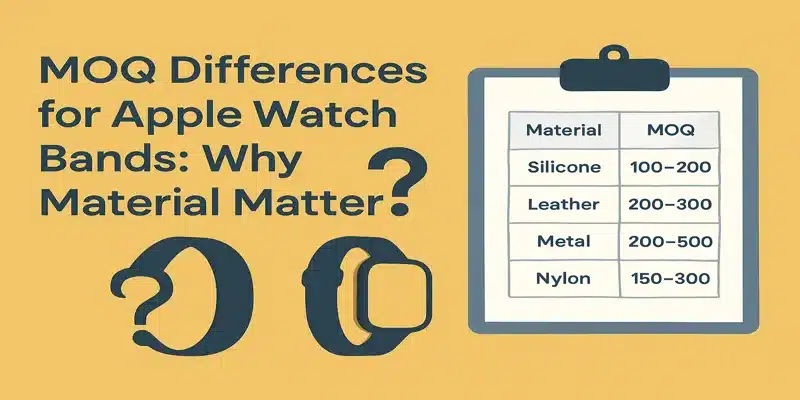
If you’re sourcing Apple Watch bands, you’ve probably noticed that MOQ requirements vary widely depending on the material. Some suppliers ask for 50 units per style, while others insist on 300 or more.
In our previous article, we explored why Apple Watch band MOQs can seem so high in general—especially for factories and manufacturers. If you missed it, take a look at Why Is the MOQ for Apple Watch Bands So High? for a breakdown of supplier perspectives and production factors.
But what if we focus specifically on the material itself? That’s what this article covers: how the material you choose directly affects MOQ—and why it’s a key factor to consider when planning your order.
✦ 01|How Material Affects MOQ
Different materials create different production challenges—and that’s why MOQ requirements vary so much. Here’s a quick overview of common materials and their typical MOQ ranges:
| Material | Typical MOQ | Why It’s Set |
|---|---|---|
| Silicone / Fluoroelastomer | 100–200 pcs | Standard molds, simple process = lower MOQ |
| Leather | 200–300 pcs | Costly raw material + handcrafting increases MOQ |
| Metal (Stainless Steel, Titanium) | 200–500 pcs | CNC machining, plating—complex setup drives MOQ up |
| Woven Nylon / Fabric | 150–300 pcs | Custom weaving, stitching—requires setup and minimum run |
The more complex or premium the material, the higher the MOQ.
✦ 02|. Can You Get Lower MOQ for Certain Materials?
Yes, but only under specific conditions:
- In-stock items: If a factory has pre-made stock (especially silicone styles), MOQ is often more flexible.
- Basic designs: Plain black or standard colors tend to have lower MOQs than custom-printed woven bands.
- Supplier type: Factories usually have strict MOQ rules, while traders or distributors may offer smaller quantities.
✦ 03|Final Thoughts: Understand Material to Manage MOQ
If you’re a new brand, it’s often smarter to start with materials that support lower MOQs—like silicone or simple leather—before jumping into complex custom designs.
👉 Remember: MOQ is not a random number. It reflects the production effort, cost, and supplier’s ability to manage small orders efficiently.
By understanding how materials impact MOQ, you can make smarter purchasing decisions and build stronger partnerships with your suppliers.
📌 Related Articles
After learning about material-based MOQ differences, you may also want to explore:
- Why Is the MOQ for Apple Watch Bands So High?
- MOQ for Custom Apple Watch Bands: What to Expect
- What’s the Difference in MOQ Between Suppliers?
📌 Explore the Full MOQ Guide
Looking for a complete overview of Apple Watch band MOQ, customization options, and supplier strategies?
Check out our comprehensive guide page here:
📞 Not sure which material fits your MOQ goals? Let us help you evaluate options and find the best path for your brand.